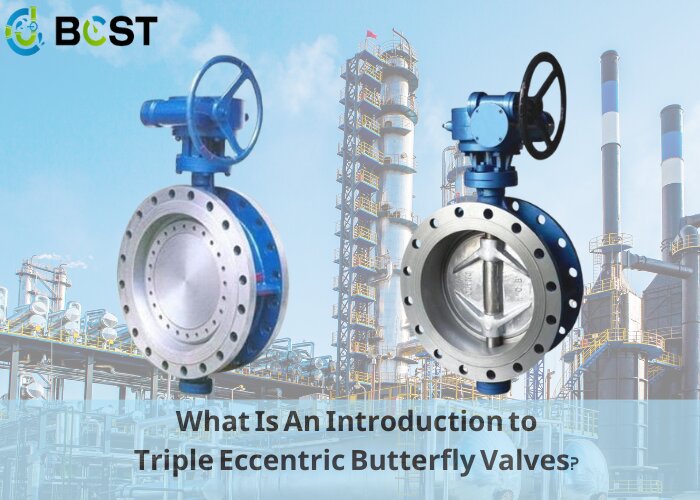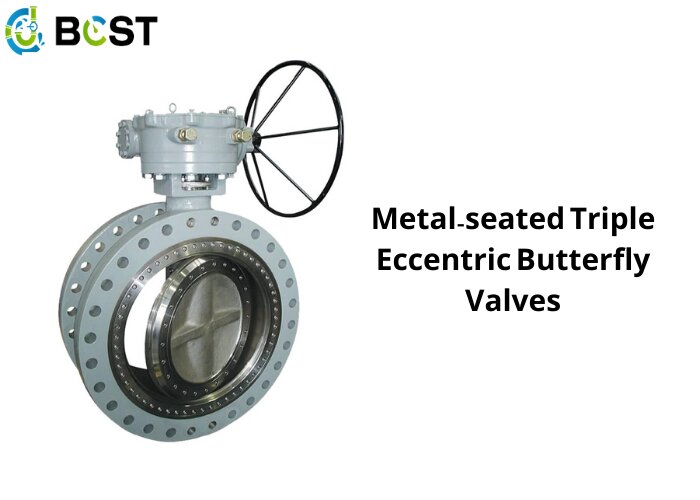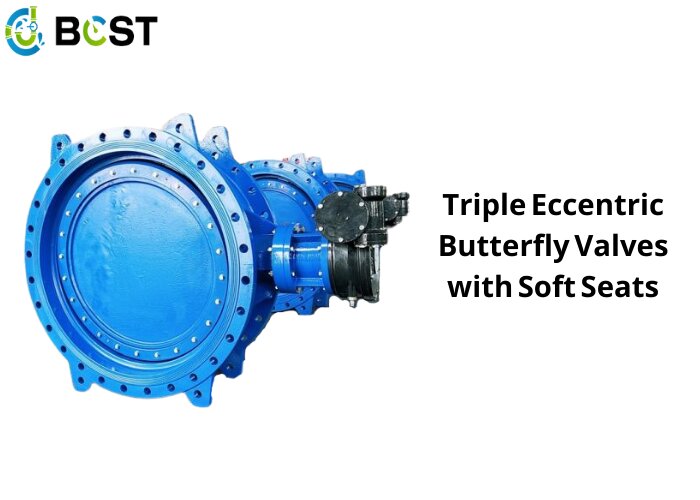
With a unique triple eccentricity in their construction, these valves offer precise control over fluid flow, making them a preferred choice in various industries. Join us on this journey as we unravel the key features, applications, and advantages that make Triple Eccentric Butterfly Valves stand out in the world of fluid control systems.
Butterfly valves are a form of quarter-turn valve that is often used to control fluid flow. With its revolutionary design, the Triple Eccentric Butterfly Valve expands on the concept. In contrast to ordinary butterfly valves, which use a simple spinning disc to close, triple eccentric butterfly valves have three separate levels of eccentricity:
- First Eccentricity:The valve shaft is positioned off-center from the valve body’s centerline. This results in a more secure seal and less wear on the sealing parts while opening and shutting.
- Second Eccentricity:The valve shaft is somewhat offset from the perpendicular axis to the valve seat plane. This feature decreases friction and wear during operation, hence extending the service life of the valve.
- Third Eccentricity:The disc’s sealing surface is conical in shape, allowing the disc to withdraw from the valve seat without friction. This construction allows for bubble-tight shut-off with minimal wear.
The following types of triple eccentric butterfly valves exist:
- Metal-seated Triple Eccentric Butterfly Valves:These valves have an excellent sealing performance and are resistant to high temperatures and corrosive fluids.

- Triple Eccentric Butterfly Valves with Soft Seats:Triple eccentric butterfly valves with soft seats and sealing discs are comprised of robust materials such as rubber or PTFE, ensuring reliable sealing and bubble-tight cutoff.

Triple eccentric butterfly valves are comprised of several critical components:
Valve Body: Valve bodies are often cast or forged from carbon steel, stainless steel, or exotic alloys. The body is constructed to resist the fluid’s pressure and temperature.
Valve Disc: The butterfly, also known as the valve disc, is linked to the valve shaft. It has a third eccentricity, which allows for a tight seal and little friction during operation.
Valve Shaft: The valve shaft is in charge of delivering torque from the actuator to the disc. It is built to withstand the forces of rotation and movement.
Seat Ring: The seat ring is where the disk makes contact with the disc to produce a tight seal. To suit various applications, it is frequently built of metal or elastomers.
Actuator: The actuator, which can be pneumatic, electric, hydraulic, or manually controlled, regulates the opening and closing of the valve. It turns energy into motion in order to change the position of the valve.
Sealing Materials: To ensure a leak-free operation, sealing materials are used in various valve parts, such as the seat ring, disc, and shaft.
Working Principles of Triple Eccentric Butterfly Valves
Triple eccentric butterfly valves operate using the triple offset design. Because the disc has triple eccentricity, the sealing edge can move away from the seat in a non-rubbing, cam-like motion, ensuring a tight and bubble-tight seal against the seat despite high pressure. When the valve is fully open, the disc is entirely free from the flow path, resulting in minimal pressure drop and unobstructed flow.
Applications of Triple Eccentric Butterfly Valves
Triple eccentric butterfly valves are used in a variety of industries due to their unique design features:
- Oil and gas:These valves manage the flow of crude oil, natural gas, and refined goods in pipelines. Their capacity to withstand high-pressure and high-temperature conditions qualifies them for use in harsh situations.
- Power Generation:Power generation uses triple eccentric butterfly valves to control the flow of steam and other fluids in boiler systems, cooling water circuits, and fuel supply lines.
- Chemical and petrochemical:The valves are used to control the flow of corrosive fluids in chemical processing plants. The third eccentricity design reduces wear and leakage while assuring safety and efficiency.
- Water Treatment:These valves govern the flow of water and chemicals in water treatment plants, providing precise control and bubble-tight shut-off.
- Marine:Triple eccentric butterfly valves are utilized in shipbuilding for a variety of applications such as ballast systems, cooling systems, and fuel lines.
- Mining:Mining involves the transfer of abrasive materials and slurries. These valves are resistant to the wear and tear that comes with such applications.
Advantages of Triple Eccentric Butterfly Valves
- Tight Sealing:The third eccentricity design maintains a tight seal even under high-pressure circumstances, reducing leakage risk.
- Low Friction:The triple eccentric design lowers friction during valve operation, prolonging valve life and lowering maintenance requirements.
- High-Temperature and High-Pressure Capabilities:These valves can handle extreme conditions, making them suitable for oil and gas and power generation industries
- Bi-Directional Flow:Triple eccentric butterfly valves offer bidirectional shutoff capabilities, providing flexibility in the flow direction.
- Tiny shape:Because of its tiny shape and quarter-turn action, the valve is ideal for applications with limited space.
Considerations for Selection
Several aspects must be addressed when selecting a triple eccentric butterfly valve for a certain application:
- The materials utilized for the valve body, disc, and sealing parts are determined by the type of fluid being conveyed.
- Temperature and pressure: To ensure that the valve operates safely and effectively, it must be selected based on the expected temperature and pressure conditions.
- Size and Flow Rate: The valve size should be chosen so that the desired flow rate is accommodated without producing undue pressure decreases.
- End Connections: The end connections of the valve should be compatible with the existing pipeline infrastructure.
- Actuator Type: The choice of actuator (pneumatic, electric, hydraulic) depends on the system’s automation level and control requirements.
- Environmental Factors: Consider ecological factors such as corrosive atmospheres, abrasive media, and outdoor installation conditions.
Final Thoughts
In conclusion, the in-depth examination of Triple Eccentric Butterfly Valves underscores their complexity and innovative design, making them an exceptional choice in fluid control systems. With a unique triple eccentricity, these valves offer precise control over fluid flow, proving indispensable in diverse industries such as oil and gas, power generation, chemical, water treatment, marine, and mining. Their three levels of eccentricity ensure tight sealing, low friction, and the ability to handle challenging conditions like high temperatures and pressures. The additional benefits of bidirectional flow, compact size, and minimal maintenance requirements underscore their versatility. The selection process involves meticulous consideration of materials, temperature, pressure, size, end connections, actuator type, and environmental factors. As robust assets, Triple Eccentric Butterfly Valves not only excel in efficient fluid control but also meet the rigorous demands of various industrial applications, showcasing precision, durability, and adaptability in the ever-evolving landscape of fluid control technology.






